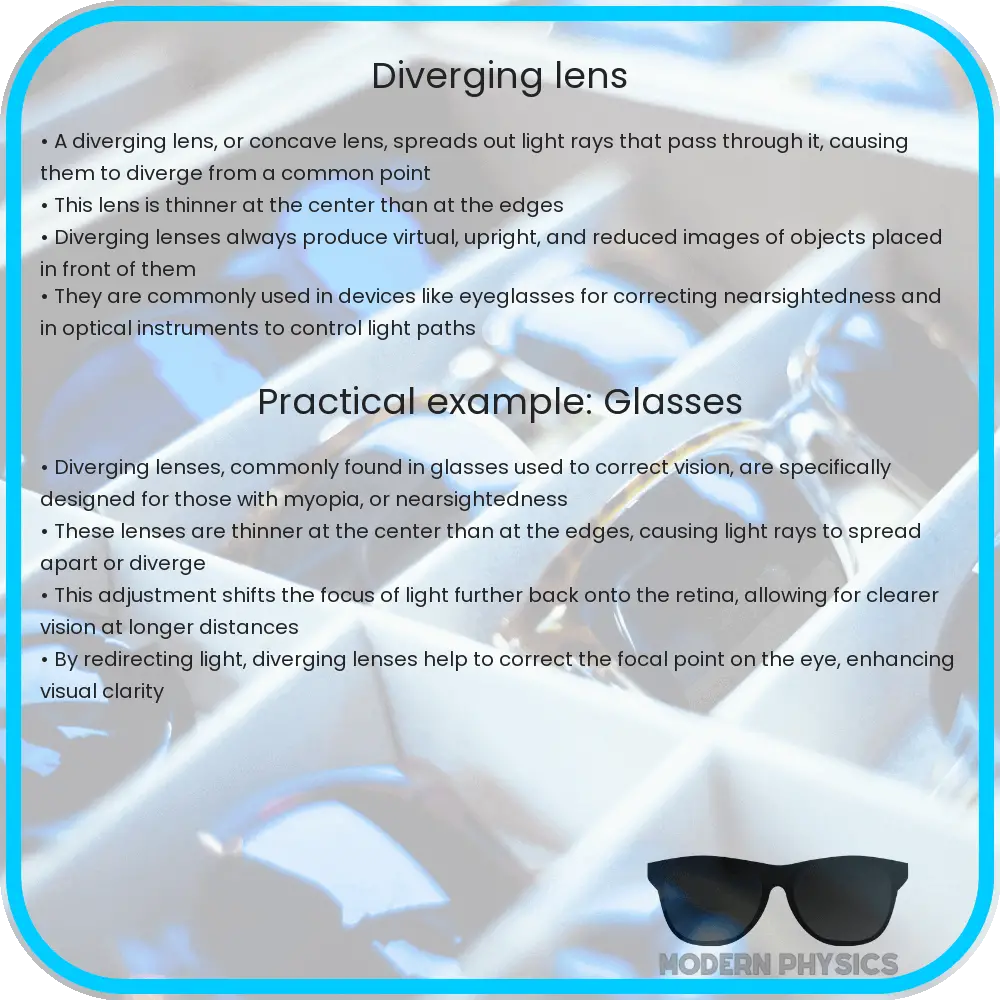Explore the world of diverging lenses in optics, covering their applications, types, and theory. Uncover how they shape vision and technology.

Understanding Diverging Lenses in Optics
Diverging lenses, also known as concave lenses, play a crucial role in the field of optics. These lenses are characterized by their ability to spread out light rays that pass through them, making them fundamental in various applications ranging from eyeglasses to sophisticated optical instruments. This article delves into the applications, types, and underlying theory of diverging lenses, offering insights into their significance in optics.
Applications of Diverging Lenses
Diverging lenses are widely utilized in a range of optical devices. One of their most common applications is in the correction of myopia or nearsightedness, where these lenses help to diverge light rays, enabling the user to see distant objects more clearly. Additionally, diverging lenses are integral components of optical instruments such as telescopes, cameras, and binoculars, where they are used to adjust the focus and enhance image quality.
Types of Diverging Lenses
There are several types of diverging lenses, each designed for specific applications. The most common types include:
- Plano-concave lenses: These lenses have one flat surface and one inwardly curved surface, making them ideal for beam expansion or increasing the focal length of an optical system.
- Bi-concave lenses: Featuring two inwardly curved surfaces, bi-concave lenses are used for light beam divergence in applications requiring moderate divergence.
- Concave meniscus lenses: Although these lenses are concave on one side, their unique shape allows them to minimize spherical aberration, making them suitable for high-precision optical tasks.
Theory Behind Diverging Lenses
The optical behavior of diverging lenses can be explained through the principles of ray tracing and the lens maker’s equation. When light rays enter a diverging lens, they are bent away from the lens’s optical axis. This phenomenon is due to the lens’s shape and the refractive index of the material it is made from. The focal point of a diverging lens is virtual, meaning that it appears to diverge from a point on the same side of the lens as the incoming light. Mathematically, the focal length of a diverging lens is represented with a negative value, indicating that the focus is virtual and not real.
Calculating Focal Length and Image Formation
To calculate the focal length of a diverging lens, the lens maker’s equation is employed, which takes into account the lens’s radius of curvature and the refractive index of the material from which the lens is made. This equation is pivotal in designing optical systems, ensuring that lenses are crafted to produce the desired effect on light rays. Image formation by diverging lenses is characterized by the production of virtual, upright, and reduced images, regardless of the position of the object in front of the lens. This is a key property that distinguishes them from converging lenses, which can produce both real and virtual images depending on the object’s location.
Advancements and Innovations in Diverging Lens Technology
The field of optics continues to evolve, with advancements in materials and manufacturing processes leading to more efficient and versatile diverging lenses. Innovations such as aspheric lens designs are minimizing spherical aberrations, enhancing the performance of optical systems that utilize diverging lenses. Furthermore, the integration of computational optics and adaptive lenses is opening new frontiers, allowing for real-time control of lens properties to suit varying optical needs.
Conclusion
Diverging lenses are indispensable in the realm of optics, offering a unique ability to diverge light rays for various applications, from vision correction to precision instruments. Understanding the types, applications, and theory behind diverging lenses is crucial for anyone looking to delve deeper into the field of optics or to apply these principles in practical scenarios. As technology advances, the potential for innovative uses of diverging lenses expands, promising exciting developments in optical sciences and applications. The ongoing research and development in this area underscore the vital role that diverging lenses play in enhancing our ability to see and interact with the world around us.
Is this conversation helpful so far?
